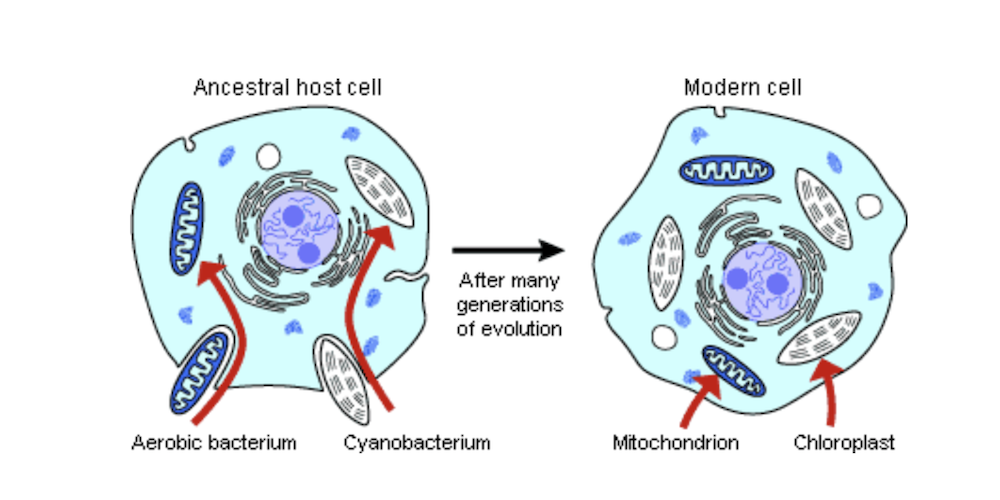Symbiogenetics
produced by: George Kuhn
A framework for analysing technology as a specialised branch of microbial community ecology. Microbial technology has over 3 billion years of history, and continues to evolve. Here I focus on symbiosis and natural selection as evolutionary logics. Following these ideas leads us on a path through US-Soviet scientific arms races, environmental disaster and real time strategy games and the war on bacterial resistance.
Symbiosis vs Neo-Darwinism
Neo-Darwinism is the body of work claiming to unite Mendelian genetics and Darwinist selection. Natural selection is applied to mutations, adaptive mutations gradually proliferate. Evolution is the result of gradual accumulation of adaptive mutations (Margulis et al., 1997, 265-282).
This model predicts a snail's pace change in traits (phyletic gradualism), but the history of evolution is highly discontinuous more closely resembling a punctuated evolution than continental drift (Eldredge & Gould, 1988). How mutations are selected for also remains unclear. In most multicellular organisms any mutation results in compensatory changes in other genes, meaning evolution proceeds by relations between compensatory mechanisms and groups of genes rather than at the level of individual genes (Dover, 1988).
Despite these problems, Neo-Darwinism was regarded as the only serious evolutionary model among 'Free World' countries until Lynn Margulis' on the Origin of Mitosing Cells, which proposed endosymbiosis as an alternative logic (Saffo, 1996). Endosymbiosis involves partners encountering each other, forming semi-stable autopoietic networks, gradually transferring metabolic and genetic material, entangling themselves until separation or recognition of partners becomes hazy (Margulis, 1976). Endosymbiotic theory had been studied since at least the, whenRussian symbionticist Konstantin Mereschowsky argued that chloroplasts were descended from free living microbes. However proponents of symbiosis in the 'Western Bloc' were viciously attacked, while funding was diverted away from symbiotic research. The dissolution of individuality central to endosymbiotic theories was likely seen as a tacit endorsement of Communist ideals.
Philosophers pf technology, working out of France during the last 100 years, separated the logic of technological evolution from that of 'natural' evolution on the basis of discontinuities between the behaviour of technology and Neo-Darwinist descriptions of evolution. These territorial lines dissolve under symbiogenetic logic, which critiques Neo-Darwinism along lines that closely follow these discontinuities.
Technical Evolution
The Invention of the Human from Bernard Stiegler's Technics and Time 1 outlines a history of philosophy of technical evolution, and extends it proposing an anatomy and logic of technology (Stiegler et al., 1998). Noticing that technological developmennt was better predicted by latitudinal position than proximity to 'cultural capitals', paleontologist André Leroi-Gourhan suggests that technological development is driven more by a zoological than human force (Leroi-Gourhan, 1945). Gilbert Simondon proposes concretisation as a mechanism of technological development; technical objects have a genetic history, and the object is manifested by the collaborative interaction of this genetic information (the interior milieu) and the environment (the associated milieu). The interior milieu, associated milieu and technical objects form a technical ensemble, who's evolution progresses by its own inhuman logic (Simondon et al., 2017).
Simondon delineates between technological and 'natural' organisms based on dissimilarities between the behaviour of a technological ensemble (as outlined above) and Neo-Darwinist evolutionary models (which were viewed as universal). Simondon describes technological evolution, in opposition to 'natural' evolution, as progressing by saltation and tending towards a unity. Lynn Margulis describes the combination of symbiosis and natural selection (symbiogenetics) as leading to this behaviour, organisms evolve by taking in new traits whole and boot-strapping them together, becoming increasingly interdependent communities ( Margulis 1976).
Symbiogenetic Anatomy of Technology
Based on strong correspondance between technical evolution and symbiogenetic evolution, as well as lack of clear boundary between the two, a speculative model of technological evolution as a specialised branch of biological community evolution can be constructed.
The unit of evolution is not the individual but the technical ensemble as holobiont, a host organism and its community of symbionts. The technical ensemble can be decomposed into a modified interior and associated milieu. The interior milieu is the data and interpretive schema that circulate the technical ensemble. The associated milieu is everything that flows through the interior milieu.
Case Study 1 : Symbiogenetic Evolution Simulator
Using this model as a template the symbiogenetic evolution simulator is a prototype for a genetic simulation based on symbiosis rather than Neo-Darwinism. While mutations still occur, the primary drivers of evolution are traits that are based on the presence of two other traits within the cell (second-order traits), symbiosis is a much faster way to 'unlock' traits, as each encounter, each predation and bacterial infection is a productive opportunity.
The model is rough but already displays some of the discontinuous saltatory behaviour displayed above. Similar to real time strategy games with 'tech trees', the tech appears to move and evolve at the level of a faction or social/cultural unit. Factions are selected for over any 'individual' unit or technology comprising them.
The technologies in the simulation are inspired from both human and in-human sources, cells can gain the technology required for motility, predation, farming, toxicity, recycling and sensation. The evolution symbiogenetic evolution simulator helps to think about technological effects across a range of granularities, tracking them as they drift across and organise simple cellular populations.
Case Study 2 : Red Tides and Chemical Chimera
K. Brevis is a single celled photosynthetic organism measuring thirty micro-meters across. Equipped with flagella (cellular motors), allowing it to move at speeds of up to a meter an hour (a million times its body length), it travels between the Yucatan Peninsula and the Straights of Florida.
Increasing carbon dioxide in the atmosphere allows the crops on surrounding K. Brevis migratory route to photosynthesis faster and faster. Humans, dependent on the plants, become a technological apparatus for it. With the surrounding human populations handling energetically costly processes for the plants (for example seed dispersal), the plants grow to towering heights. As they grow they consume more and more carbon dioxide. K. Brevis populations fall back on a discarded cellular technology to aid them with carbon fixation, turning to predation. Incomplete digestion of the anaerobic hemi-pelagic micro-fauna gives some K. Brevis the genetic information and transcription processes necessary to fix carbon from methane. Surrounded by water and with the ability to fix carbon from predation, carbon dioxide and methane, these K. Brevis flourish. They split, split and split again leading to red tide phenomenons of unprecedented scale. The beaches along from Cancun to Cape Canaveral are strewn with black tip sharks, pollock and white flounder.
Case Study 3 : Darwinian Ratchets and the War on Bacteria
Anti-microbial resistance skyrockets with the steep increase in use of antibiotics by both individuals and the aggriculture/livestock industry. The World Health Organisation identifies three strategies to combat this: surveillance, drug use policy adnd R&D. The WHO action plan houses an autocatalytic loop, with R&D enforcing run-away: overuse is identified as a threat linked to proliferation of antibiotics, and the solution involves persistant development of new antibiotics.
Eugene Thacker outlines the new mechanism of anti-microbial warfare in the US (an evolution in the technical ensemble). Emergent threats are identified, signals of danger from the future. New weapons are developed to combat these threats (pharmaceutical stockpiling). To justify cost of development and continued stockpiling, the stockpile must be used, pharmaceutical companies lobby for prescription of their products. Overuse of antibiotics cranks the Darwinian ratchet. Resistance develops and more complex threats appear on the horizon.
Bacteria are an organelle within the pharmaceutical industry as technical ensemble. The functioning of the pharmaceutical industry and the life or death of bacterial populations are reciprocally intertwined. Bacterial resistance is a resource the industry can utilise to siphon in more infrastructural support and capital, resulting in a change in the available excess energy. First order changes in excess energy require no change change in the organisation of the pharmaceutical industry as organism to accomodate, however second order (exponential increases or decreases or positive gain) pushes it to a boundary state where a new structure must be introduced or the organism fails. Resistance as a resource seems pathological in this light, continually pushing the organism out of a stable state, continually increasing the flow of resources required to keep its homeostatic processes functioning and at each boundary state risking catastrophic failure.
References
Dover, G. A. (1988). Evolving the improbable. Trends in Ecology & Evolution, 3(3), 81–84. https://doi.org/10.1016/0169-5347(88)90024-9
Eldredge, N., & Gould, S. J. (1988). Punctuated equilibrium prevails. Nature, 332(6161), 211–212. https://doi.org/10.1038/332211b0
Leroi-Gourhan, A. (1945). Milieu Et Techniques (Collections Sciences - Sciences Humaines) (French Edition). Albin Michel.
Margulis, L. (1976). Genetic and evolutionary consequences of symbiosis. Experimental Parasitology, 39(2), 277–349. https://doi.org/10.1016/0014-4894(76)90127-2
Margulis, L., & Sagan, D. (1997). Microcosmos: Four Billion Years of Microbial Evolution (First ed.). University of California Press.
Margulis, L., Sagan, D., & Morrison, P. (1997). Slanted Truths: Essays on Gaia, Symbiosis and Evolution (1997th ed.). Copernicus.
Saffo, M. B. (1996). Evolution of Symbiosis Concepts of Symbiogenesis: A Historical and Critical Study of the Research of Russian Botanists Liya N. Khakina Lynn Margulis Mark McMenamin Stephanie Merkel Robert Coalson Evolution by Association: A History of Symbiosis Jan Sapp Symbiotic Interactions Angela E. Douglas. BioScience, 46(4), 300–304. https://doi.org/10.2307/1312839
Simondon, G., Malaspina, C., & Rogove, J. (2017). On the Mode of Existence of Technical Objects. Van Haren Publishing.
Stiegler, B., Beardsworth, R., & Collins, G. (1998). Technics and Time, 1: The Fault of Epimetheus (Meridian: Crossing Aesthetics) (1st ed.). Stanford University Press

































































